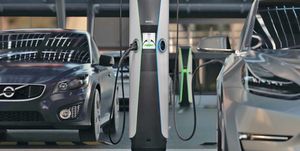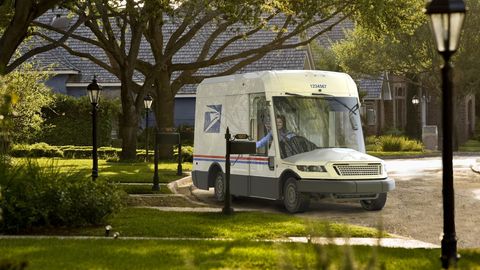On March 31, President Joe Biden unveiled what he called the American Jobs Plan in Pittsburgh. He proposed $174 billion “to win the EV market,” including point-of-sale rebates and tax incentives, and a national network of half a million EV chargers by 2030. The plan also includes replacing 50,000 diesel transit buses, and it establishes an EPA Clean Buses for Kids program, aimed at electrifying at least 20 percent of the yellow school bus fleet.
The plan drew plaudits from environmentalists. According to Katherine Garcia, a Sierra Club Clean Transportation for All deputy director, “Many of the policies that the Biden administration laid out in its infrastructure proposal today move forward our clean transportation priorities and will position the U.S. to be a leader in the EV market, after years of roadblocks and attacks on clean air and clean vehicles.”
The Zero Emission Transportation Association (ZETA) agreed, saying that going big, along the lines of the $1.9 trillion pandemic bill, is exactly what’s needed. Dan Zotos, ZETA communications director, called for an “all of the above” scenario, in which the administration fights for zero-emission vehicles with all the tools at its disposal.
The fine print on those rebates and tax credits are forthcoming, but it could include some kind of point-of-sale incentive for buyers of American-made electrics trading in gas cars (as has been proposed by Sen. Chuck Schumer). Today, automakers can offer federal income tax credits to their first 200,000 customers, which means that Tesla—the leading producer of battery cars—is no longer able to offer them.
Shruti Vaidyanathan, transportation program director at the Washington-based ACEEE advocacy group, believes that EVs will soon reach cost parity with their fossil-fuel brethren, and therefore raising the credit cap to 600,000, as some have suggested, isn’t necessary. “We split the difference, based on our research, and we think a cap of 400,000 vehicles per manufacturer is probably appropriate,” she said. The Biden plan to add a half-million charging stations, she added, is “a good starting point.”
ZETA, a new Washington-based industry trade group representing 50 member companies (including Tesla, Lucid, Rivian, Proterra and many more), wants to see the tax credit production cap lifted “until adoption rates are sufficient to ensure we meet our 2050 net-zero emissions target.” That may take awhile. EVs were just 2.4 percent of U.S. new car sales in 2020, said Canalys. They’re about 1 percent of the light-duty vehicles on American roads now.
ZETA also would like to see $30 billion invested specifically in public charging infrastructure. There are just under 100,000 of those charging outlets now. The group also supports tax incentives to encourage automakers to build EVs in the U.S., a goal also supported by the Environmental Defense Fund (EDF). “The world is moving to electric vehicles—the question is whether they’ll be built here in America or not,” said Keith Gaby, an EDF spokesman.
Electrifying government vehicles is another ZETA priority. On Jan. 27, Biden issued an executive order that called for, among other things, “clean and zero-emission vehicles federal, state, local, and tribal government fleets, including vehicles of the United States Postal Service.” The commitment was reinforced in the American Jobs Plan. But it’s a tall order, because the federal government operates approximately 645,000 vehicles. And according to Bloomberg Law, from Inauguration Day to mid-March the General Services Administration (GSA) spent $439.7 million on passenger vehicles—with only 13 percent of them having hybrid or battery drive.
One reason for this is that although there are many EV sedans and SUVs on the market now, there’s a lack of readily available, affordable, made-in-USA-with-union-labor electric work trucks. A number of companies—Rivian, Tesla, Lordstown, Bollinger—are set to soon introduce electric pickups, as are both Ford and GM, with Stellantis probable down the road. But meeting all the federal procurement price and capability targets will be difficult.
A decided setback to the government’s EV plans was the U.S. Postal Service’s recent decision to award Oshkosh Corp. a $6 billion contract for mail trucks—with, said Postmaster General Louis DeJoy, initially only 10 percent EVs.
Oshkosh said Feb. 23 that the initial $482 million of the $6 billion contract will be used to build between 50,000 and 165,000 of the right-hand-drive mail delivery vehicles “equipped with either fuel-efficient internal combustion engines or battery electric powertrains,” with retrofitting possible. But optimizing EV performance usually means starting with a vehicle that was designed for an electric powertrain.
A spokesman for Oshkosh, Bryan Brandt, said in an email, “We can deploy battery-electric vehicles, both from the customer’s first order and through retrofit to replace ICE powertrains with electric powertrains. Because of that, the Oshkosh Defense award is completely in line with President Biden’s goals related to electrification of the federal fleet and creation of new jobs in sustainable manufacturing.” But ZETA said in an analysis that the Post Service “has yet to demonstrate to the public that a ‘swappable’ drivetrain model from Oshkosh Defense exists.”
Nonetheless, the award to Oshkosh was contested by three members of Congress in Ohio, where rival Workhorse Group—which would build only electric vehicles—is based. They said the award is in “stark contrast” to Biden’s executive order. “We have serious concerns it could be a wasted opportunity to address the climate crisis and the reindustrialization of our manufacturing sector,” they said. Workhorse declined comment.
The federal response is that electric vehicles cost more. Kim Frum, a spokesperson for the Postal Service, said that the agency selected “a flexible design platform that can accommodate advancements in technology.” The challenge, Frum said, is “the Postal Service’s billions in annual operating losses. … With the right level of support, the majority of the Postal Service’s fleet can be electric by the end of the decade.” In a March 11 letter to four members of Congress, DeJoy said the 10 percent “is a floor—not a ceiling, based upon our current financial condition and the resources that we believe we will have available to invest.”
Activists say that they’d like to have a friend close to the action. The advocacy group Plug In America wants a transportation electrification czar based in the White House. And according to Joel Levin, the group’s executive director, “We’re strongly urging the Biden administration to commit to having a plug on every new car and truck by the end of this decade. It may seem like an ambitious goal, but given all of the progress that was made in the last decade, it is attainable. This is our moonshot.”
Genevieve Cullen, president of the Electric Drive Transportation Association (EDTA), agrees that a “panoramic” approach that incorporates infrastructure and tax policy is needed. “What are the levers to make this work?” she said. “Some of it is going down to the boiler room and messing with the dials.” The post office award “needs a closer look,” she said, and the cap on the income tax credit “needs to be either updated to a higher number or removed entirely.”
The Biden administration could, as three states (California, Massachusetts, and New Jersey) and many countries in Europe and around the globe have done, simply announce a goal—with a set date—for ending the sale of internal-combustion cars. Such a plan would require congressional approval, but it already has some support.
A group of 10 U.S. Senators led by Edward Markey (D-MA) called on Biden “to set a date by which new sales of fossil-fuel vehicles will end entirely.” Another group, with 70 House Democrats aboard, wants 60 percent of new passenger car and truck sales to be zero emission by 2030. California Governor Gavin Newsom pledged to end fossil-fuel sales by 2035, and the state’s two U.S. senators, Alex Padilla and Dianne Feinstein, recently urged Biden to set his own date.
The U.S. Department of Transportation referred calls to the GSA, which didn’t respond, but U.S. Transportation Secretary Pete Buttigieg said March 25 he had “not heard of anything to that effect…in a mandatory context, but that certainly seems to be where the U.S. auto industry is headed.” Biden declined to commit to such a mandate during the Presidential campaign.
A sense of urgency is emerging. “Since some vehicles last 20 years, Biden needs to phase-out gas-powered car and light truck sales by 2030 and improve the tens of millions of new internal-combustion vehicles that will be sold until then by seven percent per year, up from the five percent automakers agreed to in 2012,” said Dan Becker, director of the Safe Climate Transport Campaign at the Center for Biological Diversity. “The federal government can show the way by shifting to electric postal trucks beginning now and not at the lackadaisical pace Postmaster DeJoy has announced.”
Chime in: If you’ve had a chance to read the proposal, let us know your thoughts in the comments below.
Source: Read Full Article








